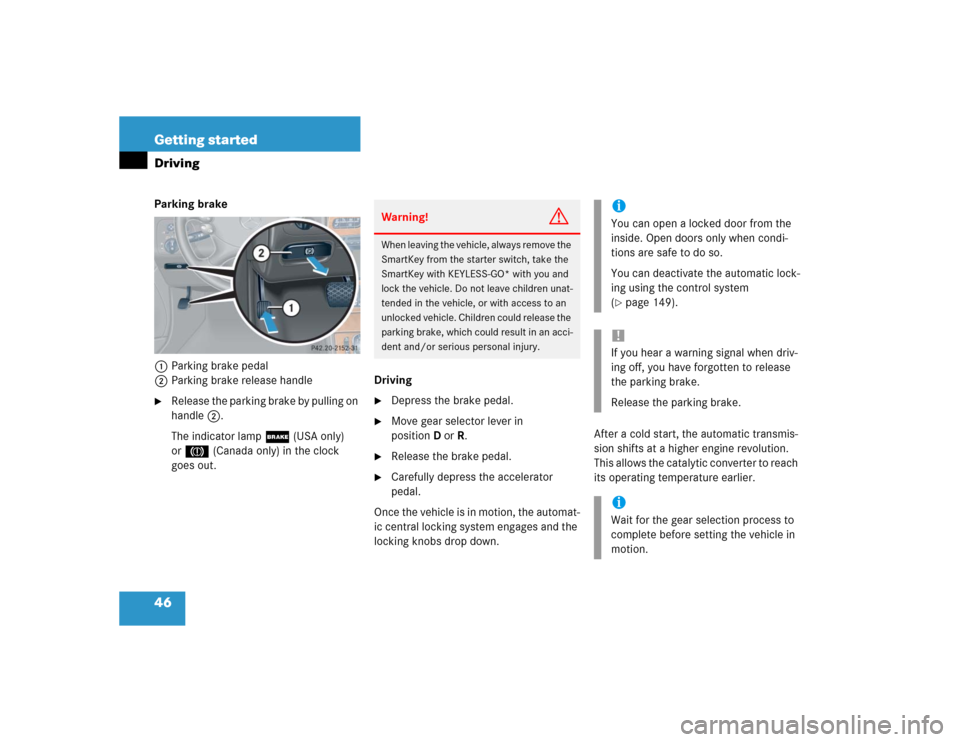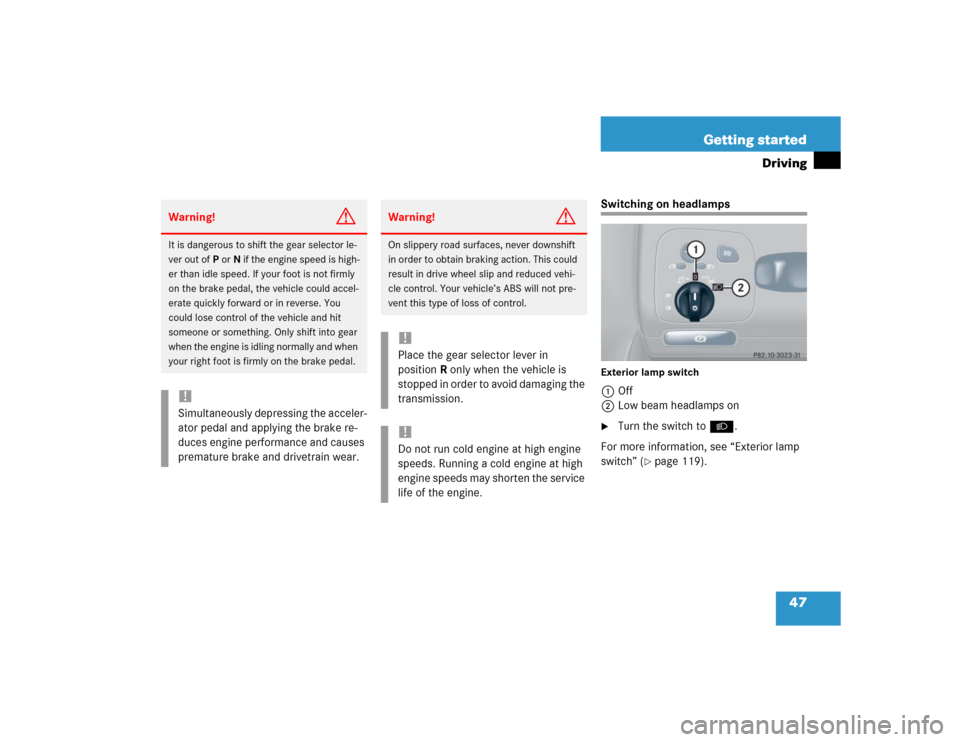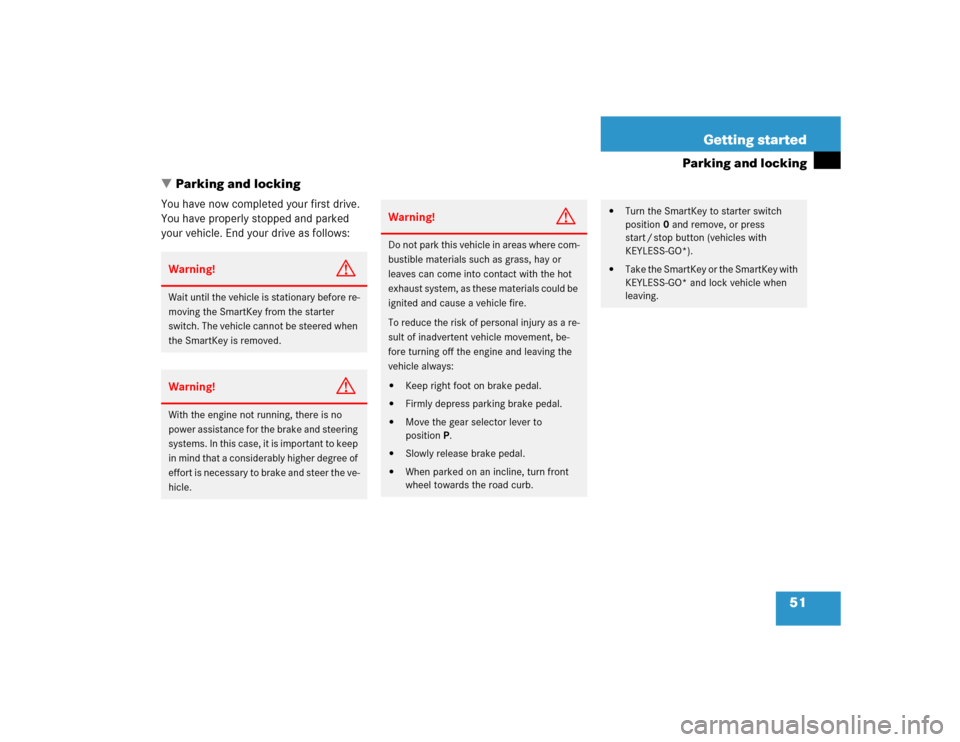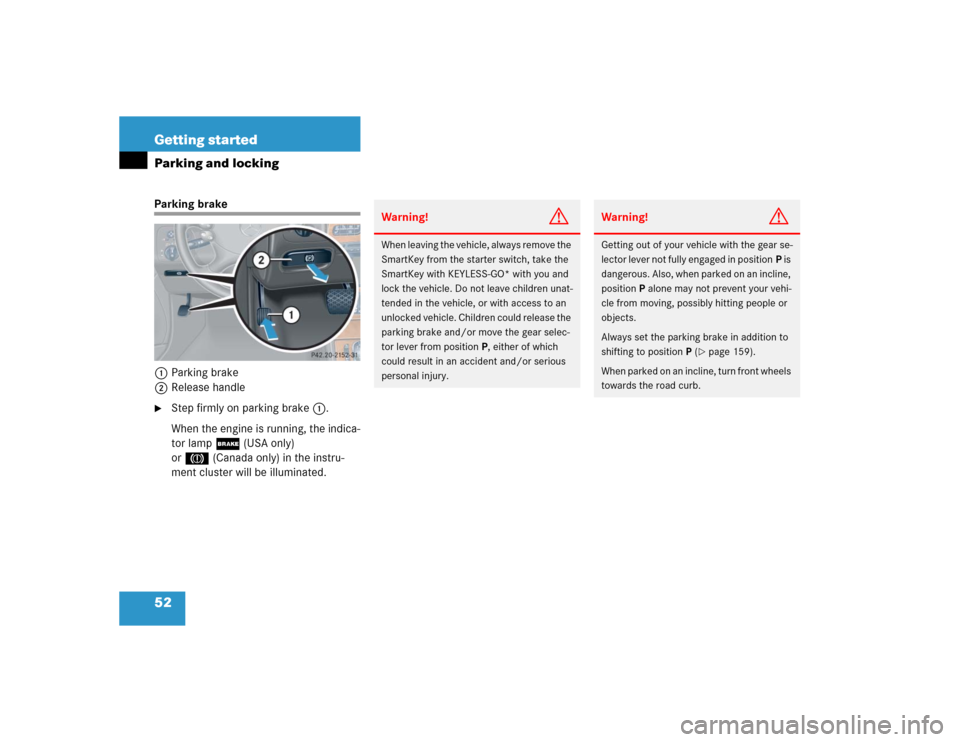Page 44 of 440
44 Getting startedDrivingAutomatic transmissionGearshift pattern for automatic
transmissionPPark position with gear selector lever
lock
RReverse gear
NNeutral
DDrive position
For more information, see “Automatic
transmission” (
�page 157).Starting with the SmartKey
�
Make sure the gear selector lever is set
toP.
�
Do not depress accelerator
�
Turn the SmartKey in the starter switch
to position3 (
�page 31) and release it
again immediately (“touch-start”).
The engine then starts automatically.
�
Depress the brake pedal.
The gear selector lever lock is released.
For information on turning off the engine
with the SmartKey, see (
�page 53).Starting with KEYLESS-GO*
You can start your vehicle without the
SmartKey in the starter switch using the
KEYLESS-GO start/stop button on the
gear selector lever.
The SmartKey with KEYLESS-GO must be
located in the vehicle.
1KEYLESS-GO start/stop button
Page 45 of 440

45 Getting started
Driving
�
M a k e s u r e t h e g e a r s e l e c t o r l e v e r i s s e t
toP.
�
Do not depress accelerator
�
Depress the brake pedal during the
starting procedure.
The gear selector lever lock is released.
�
Press KEYLESS-GO start/stop
button1 once.
The engine starts automatically if the
SmartKey with KEYLESS-GO is in the
vehicle.
For information on turning off the engine
with KEYLESS-GO, see “Turning off the en-
gine with KEYLESS-GO*” (
�page 54).Starting difficulties
If the engine does not start as described,
carry out the following steps:
�
If you are starting the engine with the
SmartKey, turn SmartKey in starter
switch to position0 and repeat starting
procedure.
�
If you are starting the engine with
KEYLESS-GO*: Close any doors that
may be open to allow for better detec-
tion of the SmartKey with
KEYLESS-GO*.
Or:
Start the engine with the SmartKey as
radio signals from another source may
be interfering with the SmartKey with
KEYLESS-GO*.
�
Repeat the starting procedure
(�page 43). Remember that extended
starting attempts can drain the battery.
�
Get a jump start (
�page 366).
If the engine does not start after several
starting attempts, there could be a mal-
function in the engine electronics or in the
fuel supply system.
�
Notify an authorized Mercedes-Benz
Center.
Page 46 of 440

46 Getting startedDrivingParking brake
1Parking brake pedal
2Parking brake release handle�
Release the parking brake by pulling on
handle2.
The indicator lamp ; (USA only)
or3 (Canada only) in the clock
goes out.Driving
�
Depress the brake pedal.
�
Move gear selector lever in
positionDorR.
�
Release the brake pedal.
�
Carefully depress the accelerator
pedal.
Once the vehicle is in motion, the automat-
ic central locking system engages and the
locking knobs drop down.After a cold start, the automatic transmis-
sion shifts at a higher engine revolution.
This allows the catalytic converter to reach
its operating temperature earlier.Warning!
G
When leaving the vehicle, always remove the
SmartKey from the starter switch, take the
SmartKey with KEYLESS-GO* with you and
lock the vehicle. Do not leave children unat-
tended in the vehicle, or with access to an
unlocked vehicle. Children could release the
parking brake, which could result in an acci-
dent and/or serious personal injury.
iYou can open a locked door from the
inside. Open doors only when condi-
tions are safe to do so.
You can deactivate the automatic lock-
ing using the control system
(�page 149).
!If you hear a warning signal when driv-
ing off, you have forgotten to release
the parking brake.
Release the parking brake.iWait for the gear selection process to
complete before setting the vehicle in
motion.
Page 47 of 440

47 Getting started
Driving
Switching on headlampsExterior lamp switch1Off
2Low beam headlamps on�
Turn the switch toB.
For more information, see “Exterior lamp
switch” (
�page 119).
Warning!
G
It is dangerous to shift the gear selector le-
ver out ofPorN if the engine speed is high-
er than idle speed. If your foot is not firmly
on the brake pedal, the vehicle could accel-
erate quickly forward or in reverse. You
could lose control of the vehicle and hit
someone or something. Only shift into gear
when the engine is idling normally and when
your right foot is firmly on the brake pedal.!Simultaneously depressing the acceler-
ator pedal and applying the brake re-
duces engine performance and causes
premature brake and drivetrain wear.
Warning!
G
On slippery road surfaces, never downshift
in order to obtain braking action. This could
result in drive wheel slip and reduced vehi-
cle control. Your vehicle’s ABS will not pre-
vent this type of loss of control.!Place the gear selector lever in
positionR only when the vehicle is
stopped in order to avoid damaging the
transmission.!Do not run cold engine at high engine
speeds. Running a cold engine at high
engine speeds may shorten the service
life of the engine.
Page 51 of 440

51 Getting started
Parking and locking
�Parking and locking
You have now completed your first drive.
You have properly stopped and parked
your vehicle. End your drive as follows:Warning!
G
Wait until the vehicle is stationary before re-
moving the SmartKey from the starter
switch. The vehicle cannot be steered when
the SmartKey is removed.Warning!
G
With the engine not running, there is no
power assistance for the brake and steering
systems. In this case, it is important to keep
in mind that a considerably higher degree of
effort is necessary to brake and steer the ve-
hicle.
Warning!
G
Do not park this vehicle in areas where com-
bustible materials such as grass, hay or
leaves can come into contact with the hot
exhaust system, as these materials could be
ignited and cause a vehicle fire.
To reduce the risk of personal injury as a re-
sult of inadvertent vehicle movement, be-
fore turning off the engine and leaving the
vehicle always:�
Keep right foot on brake pedal.
�
Firmly depress parking brake pedal.
�
Move the gear selector lever to
positionP.
�
Slowly release brake pedal.
�
When parked on an incline, turn front
wheel towards the road curb.
�
Turn the SmartKey to starter switch
position0 and remove, or press
start / stop button (vehicles with
KEYLESS-GO*).
�
Take the SmartKey or the SmartKey with
KEYLESS-GO* and lock vehicle when
leaving.
Page 52 of 440

52 Getting startedParking and lockingParking brake
1Parking brake
2Release handle�
Step firmly on parking brake1.
When the engine is running, the indica-
tor lamp ;(USA only)
or3(Canada only) in the instru-
ment cluster will be illuminated.
Warning!
G
When leaving the vehicle, always remove the
SmartKey from the starter switch, take the
SmartKey with KEYLESS-GO* with you and
lock the vehicle. Do not leave children unat-
tended in the vehicle, or with access to an
unlocked vehicle. Children could release the
parking brake and/or move the gear selec-
tor lever from positionP, either of which
could result in an accident and/or serious
personal injury.
Warning!
G
Getting out of your vehicle with the gear se-
lector lever not fully engaged in positionP is
dangerous. Also, when parked on an incline,
positionP alone may not prevent your vehi-
cle from moving, possibly hitting people or
objects.
Always set the parking brake in addition to
shifting to positionP (
�page 159).
When parked on an incline, turn front wheels
towards the road curb.
Page 53 of 440
53 Getting started
Parking and locking
Switching off headlamps�
Turn the exterior lamp switch toM
(�page 47).
For more information, see “Lighting”
(
�page 119).
Turning off the engine �
Place the gear selector lever in
positionP.Turning off the engine with the
SmartKey
�
Turn the SmartKey in the starter switch
(�page 31) to position0 and remove
it.
The immobilizer is activated.
�
Press the seat belt release button
(�page 42).
Allow the retractor to completely re-
wind the seat belt by guiding the latch
plate.
iAlways set the parking brake in addi-
tion to shifting to positionP.
On steep slopes, turn the front wheels
towards the curb.
iThe SmartKey can only be removed
from the starter switch with the gear
selector lever in positionP.!With the SmartKey removed and the
driver’s door open, a warning sounds if
the vehicle’s exterior lamps are not
switched off.
��
Page 76 of 440

76 Safety and SecurityDriving safety systems
�Driving safety systemsIn this section you will find information on
the following driving safety systems:�
ABS (A
ntilock B
rake S
ystem)
�
BAS (B
rake A
ssist S
ystem)
�
ESP (E
lectronic S
tability P
rogram)
ABS
The Antilock Brake System (ABS) regulates
the brake pressure so that the wheels do
not lock during braking. This allows you to
maintain the ability to steer your vehicle.
The ABS is functional above a speed of ap-
proximately 5 mph (8 km/h) independent
of road surface conditions.
On slippery road surfaces, the ABS will re-
spond even with light brake pressure.
iIn winter operation, the maximum ef-
fectiveness of the ABS, the BAS, and
the ESP is only achieved with winter
tires (M + S tires) or snow chains as re-
quired.
Warning!
G
The following factors increase the risk of ac-
cidents:�
Excessive speed, especially in turns
�
Wet and slippery road surfaces
�
Following another vehicle too closely
The ABS, BAS, and ESP cannot reduce this
risk.
Always adjust your driving style to the pre-
vailing road and weather conditions.
Warning!
G
Do not pump the brake pedal. Use firm,
steady brake pedal pressure instead. Pump-
ing the brake pedal defeats the purpose of
the ABS and significantly reduces braking
effectiveness.